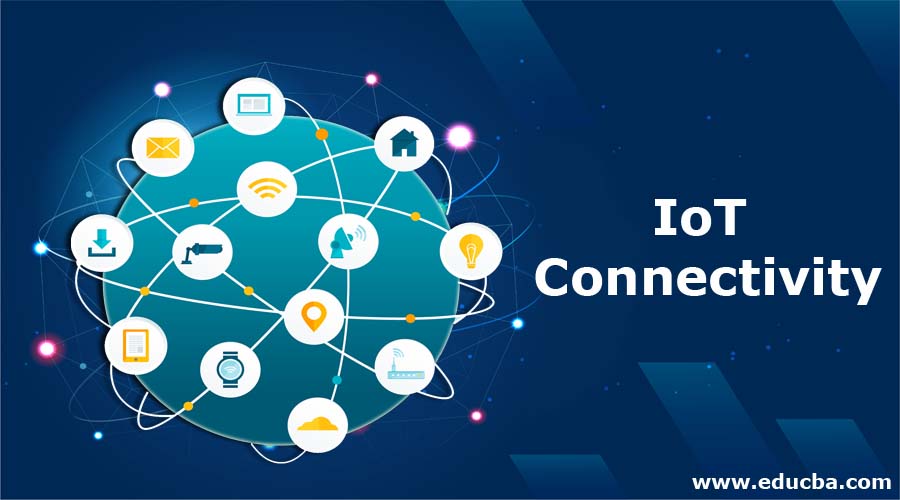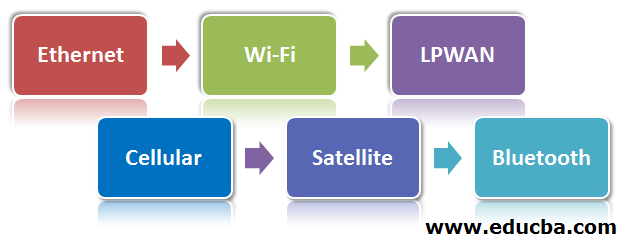Updated February 27, 2023

Introduction to IoT Connectivity
The IoT connectivity is defined as the type of technology that helps in providing the communication platform and network infrastructure used by several IoT devices for collecting, sending, and exchange the data using this platform and can be controlled by this technology. Several communication technologies are used for connecting the IoT devices. It includes LPWAN technologies, Cellular technologies, satellite technologies, and short-range wireless technology. All these technologies are vastly used for connecting the IoT device and establish communication between them. IoT connectivity aims to establish communication that consumes less power and can have an appropriate range of communication.
Explain the Different Types of IoT connectivity
In the below section some of the types of IoT connectivity are mentioned below:
1. Ethernet
The Ethernet is defined as the type of system that is used for reliably connecting the things to form the local area network. The systems are connected via the internet to form the cluster. The Ethernet system is mostly used in organizations, buildings, offices, and many other places. The Ethernet combines several nodes to a similar network. As the systems are connected by the hardwire therefore no issue of security in Ethernet.
The devices that are connected via cable is known as Ethernet cable and the device can also be charged from this by using PoE that helps in charging device. As all systems are interconnected via hardwiring the Ethernet system faces various design challenges and cannot be used in every use case as every application has certain requirements. All the nodes that are connected via an Ethernet system should be placed near to the router.
Because all systems use cables it creates a complex wired system and faced difficulty to manage all the systems. The Ethernet is mostly preferred when there is a requirement of connecting ten to twenty systems in one room. The range is very short for the Ethernet system. The feasibility of Ethernet IoT is not much compared to other IoT connecting devices.
2. Wi-Fi
The Wi-Fi is another wireless system that is used for providing internet services to the devices. In the Wi-Fi system, the dependency of the hard-wiring system is not there and the communication is done wireless. The Wi-Fi technology is comparatively faster to Ethernet.
There are some drawbacks also the power consumption of the Wi-Fi system is high and the security features are also not proper in this system. The IoT designs for the Wi-Fi system need high skill knowledge as the cost, security, and power all need to be maintained in one system. As in the modern era, there are various solutions to solve this design issue and will also save development time.
From the wi-fi system, all types of devices like smartphones, computers, laptops, and other systems can easily be connected to the internet and can also communicate among themselves without the use of any wire but in a certain area. The Wi-Fi system is the most used frequent technology for wireless communication as the hotspots are created for device connection.
3. LPWAN
The full form of LPWAN is Low power wide area network. The LPWAN is not preferred by the customers as many customers don’t have the proper knowledge. In the IoT applications, the LPWAN plays an important role. By using this system, the monitoring can be done easily as the rural areas, offshore areas and the areas that are not accessible can be monitored using LPWAN.
As the accessibility to this area is very minimal so there is a requirement of some system for the monitoring and LPWAN is a perfect option in that condition. The range for the LPWAN system is around 10 KM. The rate of data transfer is often slow but if the requirement is not there a high-speed internet is not required. The major area of use of this device is in remote and agricultural applications.
4. Cellular
The cellular is the most prominent technology that is used to cover all the areas as the coverage area of cellular technology is vast. The cost of the cellular system is comparatively higher to other systems but for a long-range, the cellular system is the best option. The user needs to get the services from the provider as own network cannot be established and it requires government license.
The benefits provided by the cellular system compensate for the price of cellular technology. An example of an IoT cellular network can be LTE. As the world is heading towards 5G technology, IoT technology will evolve very fast. The cellular network is a type of communication network in which the final link is always wireless as the customer phone is connected with the network wirelessly. The cellular network enables the facility for the user to call someone, send text messages, and use other services very easily using the cellular network.
5. Satellite
As the cellular network is used for covering maximum are but when there is the requirement to cover the desolate areas the satellite system is used. The satellite system is used for IoT applications like shipping logistics. The satellite provides signals to ship to navigate in the sea. The satellite system is not accessible for a normal person as the system is very costly and can be afforded by large organizations only. The satellite system is also used by the defense system as they require signals from all over the globe.
6. Bluetooth
Bluetooth is another type of wireless medium that has a very small range of around 100 meters. The Bluetooth is used in connecting phones with laptops or with speakers and other devices. The power consumption for Bluetooth technology is very less compared to other systems. As the technology is evolving daily the range of Bluetooth is getting extended in the next version of the system.
Conclusion
For the IoT design, the connectivity with the internet is only one step, but the IoT connectivity should be secure and the connection should be reliable. There is various type of IoT connectivity that can be used for connecting device and selection of right connectivity is completely dependent on the use case.
Recommended Articles
This is a guide to IoT Connectivity. here we discuss the various types of IoT connectivity that can be used for connecting devices in detailed explanation. You may also look at the following articles to learn more –

